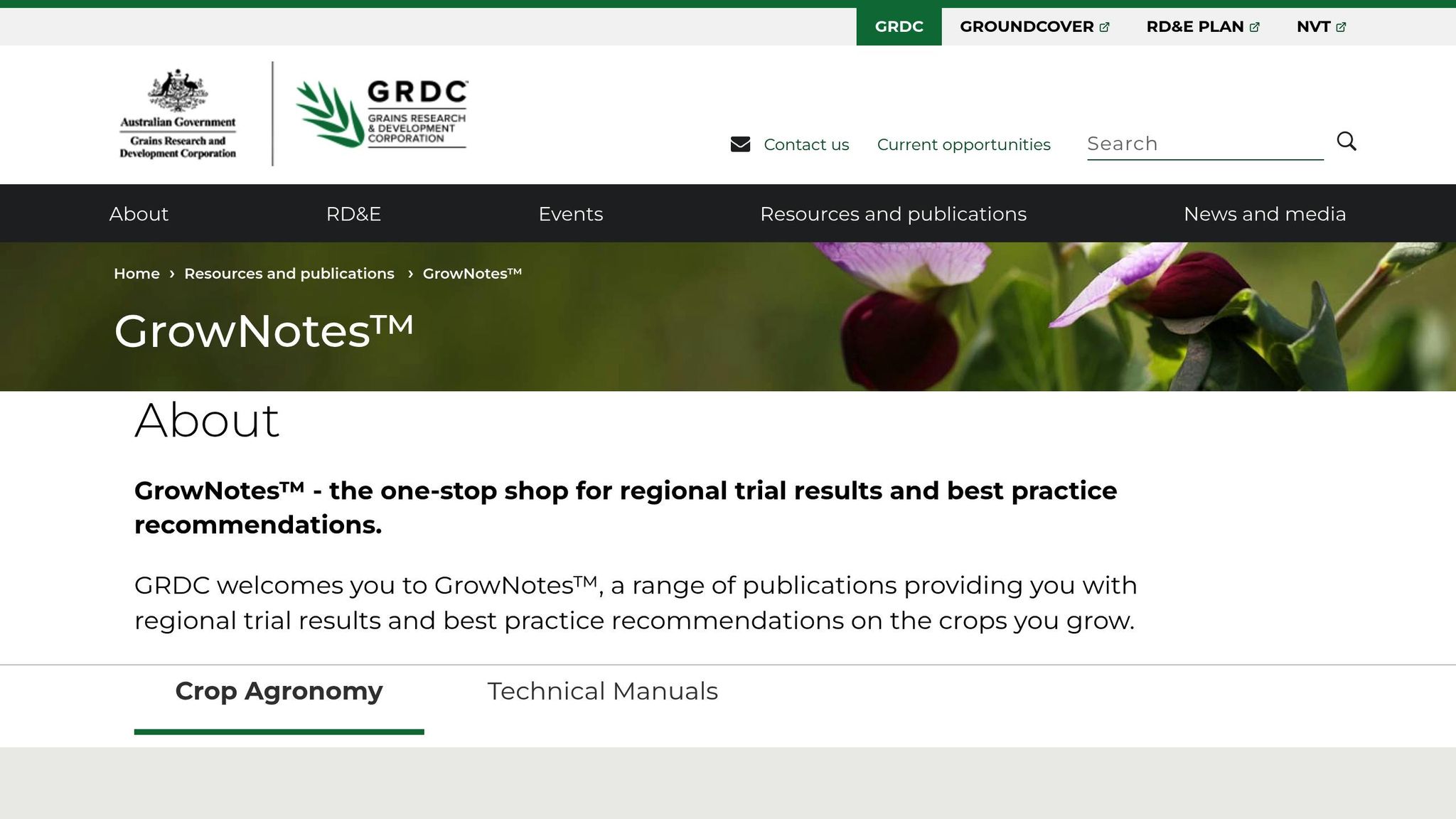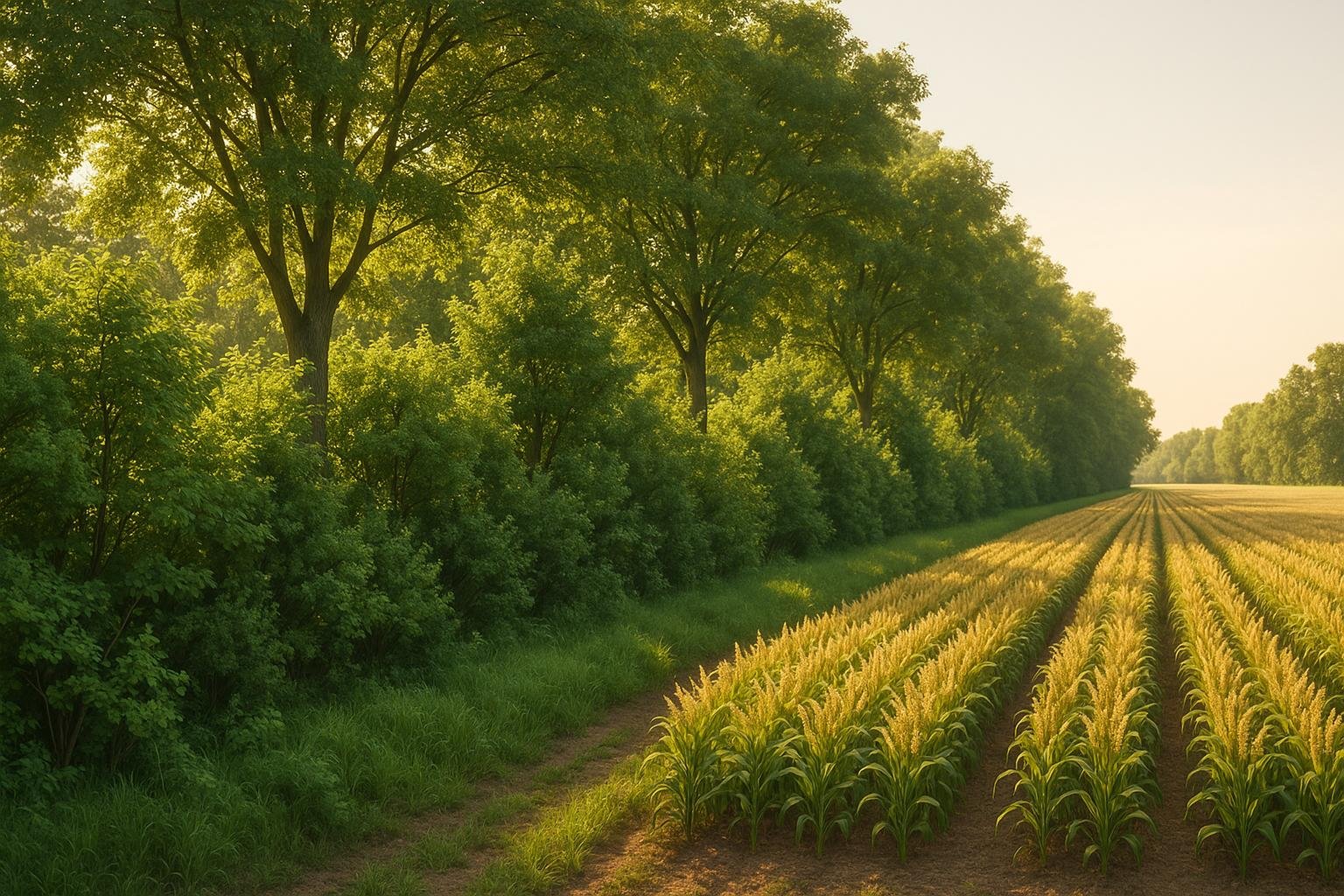Pesticide drift occurs when chemicals spread beyond their target area due to wind or vapor, potentially harming nearby crops, water sources, and ecosystems. A practical solution to mitigate this issue is the use of vegetative barriers – rows of plants that filter pesticide particles and slow wind speeds. These barriers not only reduce drift but also help protect sensitive areas like organic farms or neighboring gardens.
Key points about vegetative barriers:
- How They Work: Plants trap spray particles using their foliage, branches, and stems, reducing chemical spread by up to 82.6%.
- Design Factors: Effective barriers have 40–50% porosity, are at least twice as tall as the spraying equipment, and use a mix of plant species for better filtration.
- Types: Permanent barriers (trees, shrubs) offer long-term protection, while temporary barriers (grasses) are quick to establish and flexible.
- Placement: Barriers should align with prevailing winds and be positioned to shield vulnerable areas.
Barriers are increasingly important due to stricter regulations on pesticide use. Proper training and thoughtful planning ensure they meet legal requirements while minimizing environmental risks.
Spray Application GROWNOTES™: DRT – vegetative barriers

How Plant Barriers Reduce Pesticide Drift
Vegetative barriers provide a practical, nature-based method to tackle pesticide drift, serving as physical shields that intercept spray droplets before they can spread to unintended areas.
These barriers essentially work like natural filters. When pesticide droplets are carried by the wind, the foliage, branches, and stems of the plants trap them as air flows through. This process, often referred to as air filtration, plays a critical role in reducing off-target drift. The more textured and dense the foliage, the more effective it is at capturing and depositing pesticide particles. At the same time, a semi-permeable structure ensures that airflow continues, while still trapping the spray particles.
How Barrier Design Affects Drift Reduction
The effectiveness of a plant barrier largely depends on its design, with optical porosity being a key factor. Optical porosity refers to the amount of open space visible through the barrier from the side. Research suggests that a porosity of 40–50% – a balance between foliage and open space – works best for intercepting spray droplets. For larger pesticide particles (those over 30 micrometers), a porosity of about 20% delivers the highest deposition rates.
Height also plays a crucial role. To effectively block drifting spray, hedgerows should be at least twice the height of the spraying equipment. Additionally, using a mix of plants with varying leaf shapes, growth patterns, and sizes can significantly improve the barrier’s ability to capture pesticide particles.
How Well Plant Barriers Work
Field studies underscore the effectiveness of well-designed plant barriers, showing they can reduce spray drift by as much as 82.6%. A porosity range of 40–50% ensures an ideal balance between trapping particles and maintaining airflow, while larger droplets are particularly well-captured by the vegetation.
Types and Design Options for Plant Barriers
When it comes to reducing pesticide drift, choosing the right type and design for your plant barrier is critical. Vegetative barriers can be tailored to your specific needs, offering either permanent or temporary solutions depending on your farming practices and goals.
Permanent vs. Temporary Barriers
Permanent barriers rely on trees and shrubs to provide long-lasting protection. For instance, species like casuarina and she-oaks are excellent windbreaks, while shrubs such as tea-tree, Leptospermum, Melaleuca, and banksia offer dense foliage that effectively captures drift particles. While these barriers require a considerable upfront investment of time and resources, their durability makes them a reliable choice for sustained protection over the years.
On the other hand, temporary barriers, such as fast-growing grasses like rye and sorghum, are more adaptable. These can be planted as grass buffer belts, making them especially useful for shielding low-growing crops. Temporary barriers are also easy to integrate into crop rotation systems as cover crops, offering flexibility and quick establishment.
Here’s a quick comparison of the two options:
| Barrier Type | Advantages | Disadvantages |
|---|---|---|
| Permanent (trees, shrubs) | Long-lasting protection; effective year-round | Higher initial investment; longer time to establish; requires permanent land use |
| Temporary (grasses like rye, sorghum) | Quick to establish; lower cost; flexible placement; fits crop rotation | Seasonal use; needs replanting; limited height |
Key Design Factors
The effectiveness of your vegetative barrier depends on several design considerations:
- Plant Species Selection: Plants with fine or needle-like leaves are great for trapping drift particles, while broadleaf species excel at slowing wind speeds. Select species that thrive in your local climate and soil conditions, ensuring they grow to the required height and density. Avoid species that could attract pests harmful to your crops .
- Height: Barriers should be at least twice as tall as the crops they’re protecting to achieve optimal results.
- Density and Spacing: Aim for 40–50% density to strike the right balance between airflow and particle capture. Multiple rows of closely spaced plants work better than a single row .
- Width: Wider barriers, such as those with three rows spanning 40–50 feet, provide stronger protection against herbicide drift compared to narrower setups.
- Strategic Placement: Position barriers to intercept prevailing winds and shield the target area. Consider seasonal wind patterns and ensure the barrier won’t cast unwanted shade on your crops.
For the best results, combine plant species with long, thin, and rough foliage in multi-row designs. This approach improves the barrier’s ability to capture drift particles effectively.
sbb-itb-c4006de
Challenges and Best Practices
Best Practices for Getting Good Results
To make your barriers as effective as possible, consider these practical tips for optimizing their performance.
- Design for Airflow: Barriers should be semi-permeable to allow air to pass through while effectively trapping spray particles and dust.
- Height Matters: Ensure your vegetative barrier stands at least twice as tall as the crop you’re protecting.
- Strategic Placement: Position barriers along crop boundaries, near sensitive areas, between blocks or paddocks, or even along sprinkler rows for low-growing crops. Multi-row barriers can be especially effective in reducing drift.
- Choose the Right Plants: Opt for plant species with long, thin, and rough foliage, which are particularly good at capturing particles. Refer to the recommended species mentioned in the earlier design section.
Regulations and Training Options
U.S. Regulations for Drift Control
In the U.S., federal law requires certification for anyone applying or supervising the use of Restricted Use Pesticides (RUPs). This ensures they understand their legal responsibilities when it comes to preventing pesticide drift. Drift management is a key part of the certification process for both private and commercial pesticide applicators. For commercial applicators, the rules specifically demand practical knowledge of "Prevention of drift and pesticide loss into the environment" as a critical part of their application methods. Additionally, certain categories of commercial applicators – such as those in Agricultural (Crop), Forest, Ornamental and Turf, and Right-of-Way sectors – must meet stricter drift control requirements.
Meeting these high standards calls for hands-on, practical training.
Training Resources for Pesticide Applicators
Platforms like Online Pest Control Courses offer state-approved training tailored to drift management and environmental protection. These courses cover a range of topics including pesticide laws, formulations, environmental effects, and integrated pest management strategies. They also provide practical lessons on using vegetative barriers and other drift control techniques, helping applicators determine the best methods and timing for implementation.
The courses are accessible on multiple devices, allowing applicators to earn required continuing education units (CEUs) or continuing competency units (CCUs) at their convenience. With instant certification upon completion, these programs ensure applicators stay up-to-date with regulatory requirements while offering actionable tips for selecting and positioning plant barriers effectively.
Conclusion
Vegetative barriers present a practical way to minimize pesticide drift while protecting nearby plants and the environment. According to Agriculture Victoria:
A good vegetative barrier works by allowing air to pass through foliage while filtering out spray particles and reducing possible damage to human health, the environment, crops and livestock.
These barriers are highly effective at capturing spray droplets, reducing the risk of drift even under varying wind conditions, and shielding surrounding areas from potential harm.
However, the effectiveness of vegetative barriers hinges on careful planning and upkeep. Key factors like barrier height, density, porosity, and their distance from spray zones are critical to their success. Whether opting for permanent plantings or temporary setups, applicators must evaluate site-specific conditions and stay mindful of any regulatory requirements. Proper training is essential to master these elements and ensure compliance with safety standards.
To implement vegetative barriers effectively, applicators need to understand pesticide behavior, environmental dynamics, and legal guidelines. Platforms like Online Pest Control Courses offer state-approved education that covers drift control techniques, environmental safeguards, and integrated pest management strategies, making it easier for professionals to gain the necessary expertise.
With the right training and a well-thought-out approach, applicators can significantly reduce pesticide drift risks while maintaining effective pest management practices through the use of vegetative barriers.
FAQs
What makes vegetative barriers effective for controlling pesticide drift?
Vegetative barriers serve as a natural and efficient solution to curb pesticide drift. Made up of trees, shrubs, or tall grasses, these barriers can capture 70-90% of airborne pesticide droplets, drastically reducing their spread. They work by intercepting spray droplets and slowing down wind, which helps shield nearby plants, water sources, and other sensitive areas from exposure.
Unlike methods such as buffer zones or specialized nozzles, vegetative barriers provide a long-lasting and continuous benefit once they are in place. This makes them especially useful in regions where reducing pesticide impact is a high priority, offering a reliable way to improve safety and protect the surrounding environment.
What are the benefits of using a variety of plants in a vegetative barrier?
Using a variety of plant species in a vegetative barrier comes with multiple benefits. For starters, biodiversity plays a key role in naturally managing pests, which can reduce the reliance on chemical pesticides and contribute to healthier ecosystems. Plus, it attracts beneficial insects like pollinators, helping to maintain ecological balance.
Beyond that, planting a mix of species can improve soil health, filter runoff to enhance water quality, and offer stronger protection against pesticide drift. This method also supports the resilience of nearby native plants, creating a ripple effect that promotes a healthier environment over time.
Where should farmers place vegetative barriers to reduce pesticide drift effectively?
To get the best results from vegetative barriers, farmers should place them as close as they can to the source of pesticide application. For optimal performance, these barriers should stand at least twice as tall as the equipment used to apply the pesticides, ensuring they can effectively intercept drifting spray.
Positioning the barriers perpendicular to the prevailing wind direction and planting them with thick, perennial vegetation boosts their ability to block and filter pesticide drift. This setup provides stronger protection for nearby areas like crops, water sources, or residential zones that could be affected.






